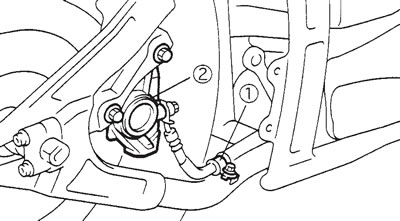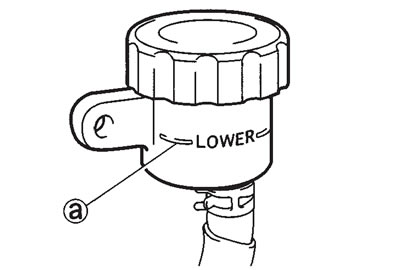Note: When replacing the brake pads, it is not necessary to disconnect the brake hose or disassemble the brake caliper.
1. Remove:
- brake hose holder (1)
- brake caliper (2)

2. Remove:
- brake pad cover
- brake pad clips
- brake pad pins
- brake pad spring
3. Remove: brake pads (along with the brake pad shims)
4. Measure: brake pad wear limit (a)
Out of specification → Replace the brake pads as a set.

Brake pad wear limit: 0.5 mm
5. Install:
- brake pad shims (onto the brake pads)
- brake pads
- brake pad spring
Note: Always install new brake pads, brake pad shims, and a brake pad spring as a set.
a. Connect a clear plastic hose (1) tightly to the bleed screw (2). Put the other end of the hose into an open container.

b. Loosen the bleed screw and push the brake caliper pistons into the brake caliper with your finger.
c. Tighten the bleed screw.
- Bleed screw: 6 Nm (0.6 m·kg)
d. Install new brake pad shims onto the new brake pads.
e. Install new brake pads and a new brake pad spring.
Note: The longer tangs (a) on the brake pad spring must point in the direction of disc rotation.

6. Install:
- brake pad pins brake pad clips
- brake pad cover
- brake caliper: 40 Nm (4.0 m·kg)
7. Check: brake fluid level
Below the minimum level mark (a) → Add the recommended brake fluid to the proper level. Refer to "Checking the brake fluid level".

8. Check: brake pedal operation
Soft or spongy feeling → Bleed the brake system. Refer to "Bleeding the hydraulic brake system".
